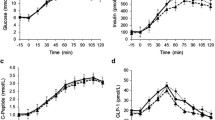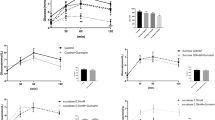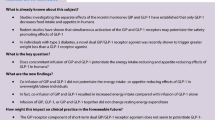Abstract
Background and Aim
Mosapride citrate—a prokinetic agent—improves hemoglobin A1c levels in diabetic patients; however, the underlying mechanism is unclear. We aimed to clarify this mechanism.
Methods
Preprandial and postprandial (90 min after a meal) blood was obtained from 12 healthy men, and serum insulin and plasma active glucagon-like peptide-1 concentrations were measured. Measurements were also taken after the administration of 5 mg of mosapride citrate three times per day after every meal for 14 days. In addition, C57BL/6 mice were permitted free access to water containing 0.04 % domperidone (D group) or 0.02 % mosapride citrate (M group) for 2 weeks (four mice per group). T1r2 (taste receptor, type 1, member 2), T1r3, and Gnat3 (guanine nucleotide-binding protein, alpha transducing 3) mRNA expression levels of the stomach, duodenum, and proximal and mid-jejunum were evaluated.
Results
In human subjects, postprandial plasma active glucagon-like peptide-1 and serum insulin concentrations after administration of mosapride citrate were significantly higher than those pre-administration (4.8 ± 2.2 pmol/L, 45.6 ± 41.6 μIU/mL, and 3.7 ± 1.2 pmol/L, 34.1 ± 28.4 μIU/mL, respectively). The mouse expression levels of T1r2 and Gnat3 in the proximal jejunum and mid-jejunum in the M group (4.1 ± 1.8-fold, 3.1 ± 1.6-fold, and 4.6 ± 0.8-fold, 3.1 ± 0.9-fold increases, respectively), were significantly higher than those of the control group.
Conclusions
The administration of mosapride citrate for 2 weeks enhanced postprandial plasma active glucagon-like peptide-1 and serum insulin concentration and increased the expression of sweet taste receptors in the upper intestine.



Similar content being viewed by others
Abbreviations
- BMI:
-
Body mass index
- ER:
-
Endoplasmic reticulum
- GLP-1:
-
Glucagon-like peptide-1
- GNAT3:
-
Guanine nucleotide-binding protein, alpha transducing 3
- t1/2 :
-
Half-life
- HbA1c:
-
Hemoglobin A1c
- IP3:
-
Inositol 1,4,5-triphosphate
- IP3R3:
-
Inositol 1,4,5-triphosphate receptor type 3
- PLCβ2:
-
Phospholipase Cβ2
- RT-PCR:
-
Reverse transcription PCR
- T1R2:
-
Taste receptor, type 1, member 2
- T1R3:
-
Taste receptor, type 1, member 3
- TRPM5:
-
Transient receptor potential channel 5
- VGCC:
-
Voltage-gated calcium channel
References
Yoshida N, Ito T, Karasawa T, Itoh Z. AS-4370, a new gastrokinetic agent, enhances upper gastrointestinal motor activity in conscious dogs. J Pharmacol Exp Ther. 1991;257:781–787.
Mine Y, Yoshikawa T, Oku S, Nagai R, Yoshida N, Hosoki K. Comparison of effect of mosapride citrate and existing 5-HT4 receptor agonists on gastrointestinal motility in vivo and in vitro. J Pharmacol Exp Ther. 1997;283:1000–1008.
Hongo M, Harasawa S, Mine T, et al. Large-scale randomized clinical study on functional dyspepsia treatment with mosapride or teprenone: Japan Mosapride Mega-Study (JMMS). J Gastroenterol Hepatol. 2012;27:62–68.
Ueno N, Inui A, Asakawa A, et al. Mosapride, a 5HT-4 receptor agonist, improves insulin sensitivity and glycaemic control in patients with Type II diabetes mellitus. Diabetologia. 2002;45:792–797.
Koshiyama H, Shimono D, Wada Y, Nakamura Y. Improvement of glycemic control after treatment with mosapride for diabetic gastropathy. Diabetes Care. 2000;23:1198–1199.
Nam JS, Nam JY, Yoo JS, et al. The effect of mosapride (5HT-4 receptor agonist) on insulin sensitivity and GLUT4 translocation. Diabetes Res Clin Pract. 2010;87:329–334.
Drucker DJ, Nauck MA. The incretin system: glucagon-like peptide-1 receptor agonists and dipeptidyl peptidase-4 inhibitors in type 2 diabetes. Lancet. 2006;368:1696–1705.
Creutzfeldt W. The incretin concept today. Diabetologia. 1979;16:75–85.
Kieffer TJ, Habener JF. The glucagon-like peptides. Endocr Rev. 1999;20:876–913.
Jang HJ, Kokrashvili Z, Theodorakis MJ, et al. Gut-expressed gustducin and taste receptors regulate secretion of glucagon-like peptide-1. Proc Natl Acad Sci U S A. 2007;104:15069–15074.
Margolskee RF, Dyer J, Kokrashvili Z, et al. T1R3 and gustducin in gut sense sugars to regulate expression of Na + -glucose cotransporter 1. Proc Natl Acad Sci U S A. 2007;104:15075–15080.
Gerspach AC, Steinert RE, Schönenberger L, Graber-Maier A, Beglinger C. The role of the gut sweet taste receptor in regulating GLP-1, PYY, and CCK release in humans. Am J Physiol Endocrinol Metab. 2011;301:E317–E325.
Dyer J, Salmon KS, Zibrik L, Shirazi-Beechey SP. Expression of sweet taste receptors of the T1R family in the intestinal tract and enteroendocrine cells. Biochem Soc Trans. 2005;33:302–305.
Mace OJ, Affleck J, Patel N, Kellett GL. Sweet taste receptors in rat small intestine stimulate glucose absorption through apical GLUT2. J Physiol. 2007;582:379–392.
Mannucci E, Ognibene A, Cremasco F, et al. Effect of metformin on glucagon-like peptide 1 (GLP-1) and leptin levels in obese nondiabetic subjects. Diabetes Care. 2001;24:489–494.
Michiels M, Hendriks R, Heykants J. On the pharmacokinetics of domperidone in animals and man II. Tissue distribution, placental and milk transfer of domperidone in the Wistar rat. Eur J Drug Metab Pharmacokinet. 1981;6:37–48.
Livak KJ, Schmittgen TD. Analysis of relative gene expression data using real-time quantitative PCR and the 2(-Delta Delta C(T)) Method. Methods. 2001;25:402–408.
Bezençon C, le Coutre J, Damak S. Taste-signaling proteins are coexpressed in solitary intestinal epithelial cells. Chem Senses. 2007;32:41–49.
Quigley EM. The pathophysiology of diabetic gastroenteropathy: more vague than vagal. Gastroenterology. 1997;113:1790–1794.
Koch KL. Diabetic gastropathy: gastric neuromuscular dysfunction in diabetes mellitus: a review of symptoms, pathophysiology, and treatment. Dig Dis Sci. 1999;44:1061–1075.
Ueno N, Inui A, Satoh Y. The effect of mosapride citrate on constipation in patients with diabetes. Diabetes Res Clin Pract. 2010;87:27–32.
Hosaka H, Kusano M, Zai H, et al. Monosodium glutamate stimulates secretion of glucagon-like peptide-1 and reduces postprandial glucose after a lipid-containing meal. Aliment Pharmacol Ther. 2012;36:895–903.
Göke B, Fuder H, Wieckhorst G, et al. Voglibose (AO-128) is an efficient alpha-glucosidase inhibitor and mobilizes the endogenous GLP-1 reserve. Digestion. 1995;56:493–501.
Lee A, Patrick P, Wishart J, Horowitz M, Morley JE. The effects of miglitol on glucagon-like peptide-1 secretion and appetite sensations in obese type 2 diabetics. Diabetes Obes Metab. 2002;4:329–335.
Ellingsgaard H, Hauselmann I, Schuler B, et al. Interleukin-6 enhances insulin secretion by increasing glucagon-like peptide-1 secretion from L cells and alpha cells. Nat Med. 2011;17:1481–1489.
Migoya E, Miller J, Luo WL, et al. Sitagliptin and metformin increase active GLP-1 by complementary mechanisms in treat-naïve patients with type 2 diabetes [Abstract]. Diabetes. 2010;59:A156.
Aoki K, Kamiyama H, Masuda K, Togashi Y, Terauchi Y. Mosapride citrate, a 5-HT(4) receptor agonist, increased the plasma active and total glucagon-like peptide-1 levels in non-diabetic men. Endocr J. 2013;60:493–499.
Romero F, Nicolau J, Flores L, et al. Comparable early changes in gastrointestinal hormones after sleeve gastrectomy and Roux-En-Y gastric bypass surgery for morbidly obese type 2 diabetic subjects. Surg Endosc. 2012;26:2231–2239.
Gebhard B, Holst JJ, Biegelmayer C, Miholic J. Postprandial GLP-1, norepinephrine, and reactive hypoglycemia in dumping syndrome. Dig Dis Sci. 2001;46:1915–1923.
Eissele R, Göke R, Willemer S, et al. Glucagon-like peptide-1 cells in the gastrointestinal tract and pancreas of rat, pig and man. Eur J Clin Invest. 1992;22:283–291.
Sakashita M, Yamaguchi T, Miyazaki H, et al. Pharmacokinetics of the gastrokinetic agent mosapride citrate after single and multiple oral administrations in healthy subjects. Arzneimittelforschung. 1993;43:867–872.
Rössler P, Kroner C, Freitag J, Noè J, Breer H. Identification of a phospholipase C beta subtype in rat taste cells. Eur J Cell Biol. 1998;77:253–261.
Prawitt D, Monteilh-Zoller MK, Brixel L, et al. TRPM5 is a transient Ca2+-activated cation channel responding to rapid changes in [Ca2 +]i. Proc Natl Acad Sci U S A. 2003;100:15166–15171.
Höfer D, Püschel B, Drenckhahn D. Taste receptor-like cells in the rat gut identified by expression of alpha-gustducin. Proc Natl Acad Sci U S A. 1996;93:6631–6634.
Pérez CA, Huang L, Rong M, et al. A transient receptor potential channel expressed in taste receptor cells. Nat Neurosci. 2002;5:1169–1176.
Hass N, Schwarzenbacher K, Breer H. T1R3 is expressed in brush cells and ghrelin-producing cells of murine stomach. Cell Tissue Res. 2010;339:493–504.
Young RL, Sutherland K, Pezos N, et al. Expression of taste molecules in the upper gastrointestinal tract in humans with and without type 2 diabetes. Gut. 2009;58:337–346.
Nelson G, Chandrashekar J, Hoon MA, et al. An amino-acid taste receptor. Nature. 2002;416:199–202.
Hansen L, Lampert S, Mineo H, Holst JJ. Neural regulation of glucagon-like peptide-1 secretion in pigs. Am J Physiol Endocrinol Metab. 2004;287:E939–E947.
Schirra J, Katschinski M, Weidmann C, et al. Gastric emptying and release of incretin hormones after glucose ingestion in humans. J Clin Invest. 1996;97:92–103.
Nauck MA, Siemsglüss J, Orskov C, Holst JJ. Release of glucagon-like peptide 1 (GLP-1 [7-36 amide]), gastric inhibitory polypeptide (GIP) and insulin in response to oral glucose after upper and lower intestinal resections. Z Gastroenterol. 1996;34:159–166.
Ueno N, Inui A, Asakawa A, et al. Erythromycin improves glycaemic control in patients with Type II diabetes mellitus. Diabetologia. 2000;43:411–415.
Farup CE, Leidy NK, Murray M, Williams GR, Helbers L, Quigley EM. Effect of domperidone on the health-related quality of life of patients with symptoms of diabetic gastroparesis. Diabetes Care. 1998;21:1699–1706.
Patterson D, Abell T, Rothstein R, Koch K, Barnett J. A double-blind multicenter comparison of domperidone and metoclopramide in the treatment of diabetic patients with symptoms of gastroparesis. Am J Gastroenterol. 1999;94:1230–1234.
Nakagawa Y, Nagasawa M, Yamada S, et al. Sweet taste receptor expressed in pancreatic beta-cells activates the calcium and cyclic AMP signaling systems and stimulates insulin secretion. PLoS One. 2009;4:e5106.
Brown RJ, Walter M, Rother KI. Ingestion of diet soda before a glucose load augments glucagon-like peptide-1 secretion. Diabetes Care. 2009;32:2184–2186.
Fujita Y, Wideman RD, Speck M, et al. Incretin release from gut is acutely enhanced by sugar but not by sweeteners in vivo. Am J Physiol Endocrinol Metab. 2009;296:E473–E479.
Wu T, Bound MJ, Standfield SD, et al. Artificial sweeteners have no effect on gastric emptying, glucagon-like peptide-1, or glycemia after oral glucose in healthy humans. Diabetes Care. 2013;36:e202–e203.
Steinert RE, Gerspach AC, Gutmann H, Asarian L, Drewe J, Beglinger C. The functional involvement of gut-expressed sweet taste receptors in glucose-stimulated secretion of glucagon-like peptide-1 (GLP-1) and peptide YY (PYY). Clin Nutr. 2011;30:524–532.
Conflict of interest
None.
Author information
Authors and Affiliations
Corresponding author
Rights and permissions
About this article
Cite this article
Maruoka, D., Arai, M., Tanaka, T. et al. Mosapride Citrate Increases Postprandial Glucagon-Like Peptide-1, Insulin, and Gene Expression of Sweet Taste Receptors. Dig Dis Sci 60, 345–353 (2015). https://doi.org/10.1007/s10620-014-3271-7
Received:
Accepted:
Published:
Issue Date:
DOI: https://doi.org/10.1007/s10620-014-3271-7




